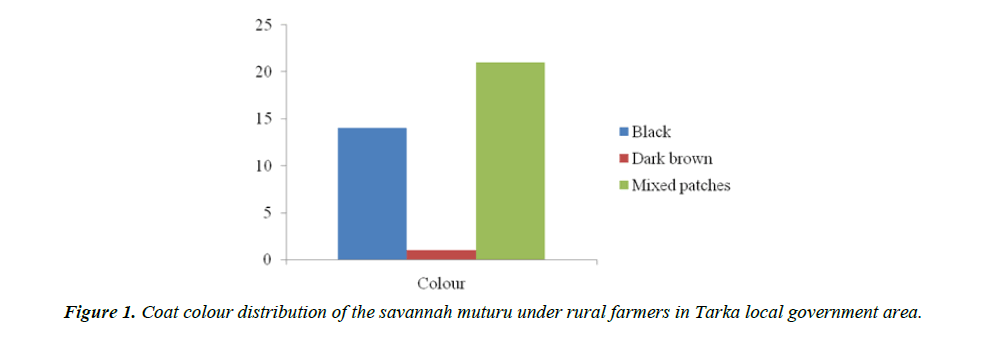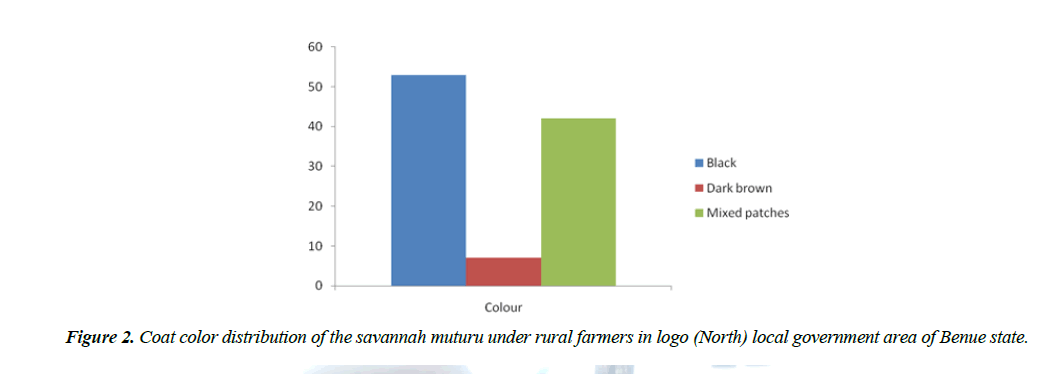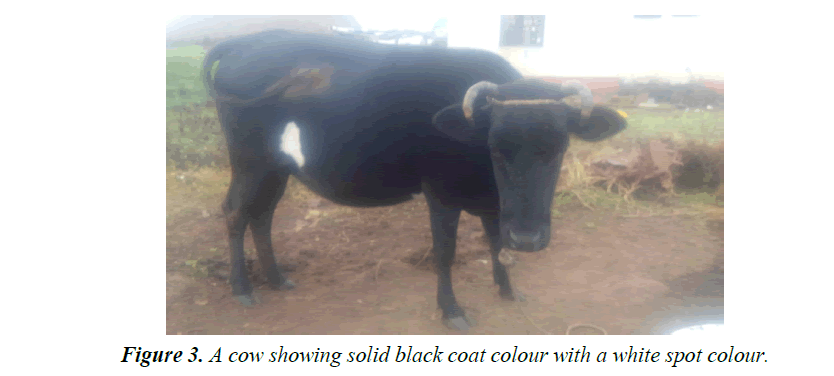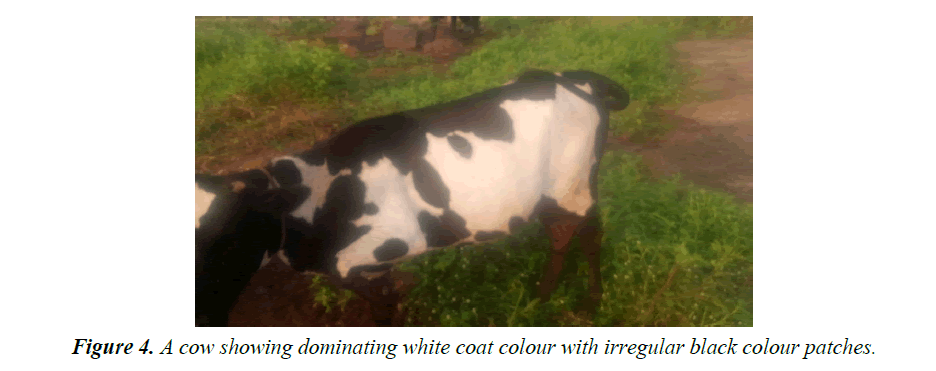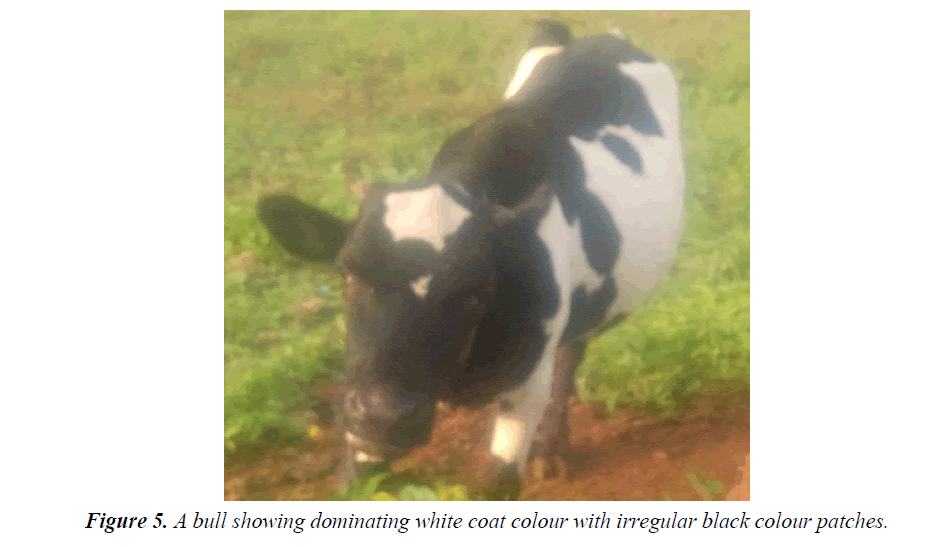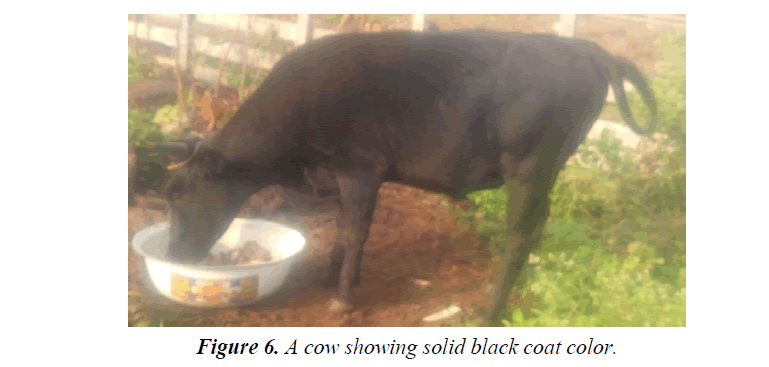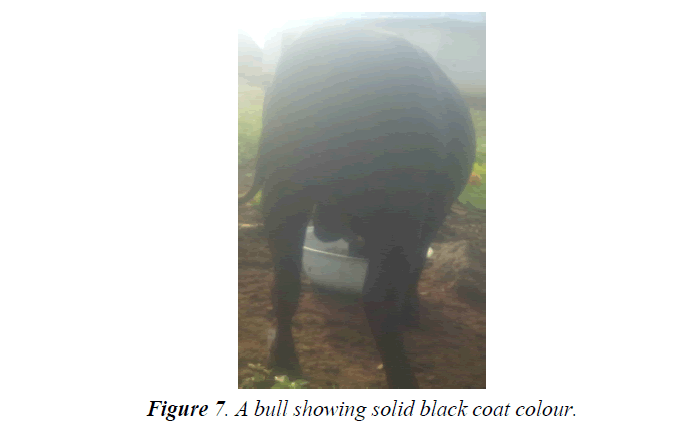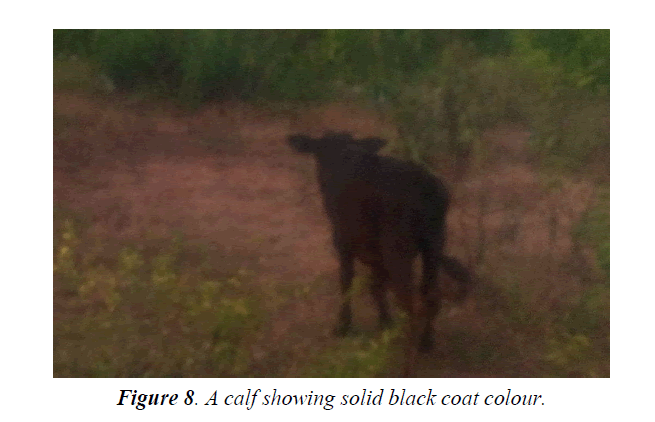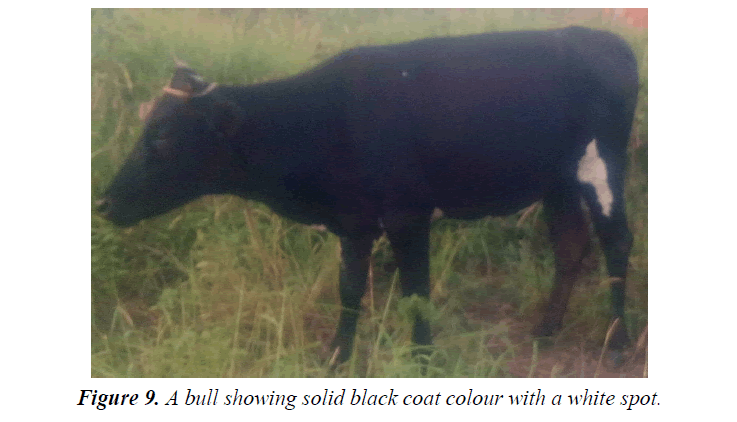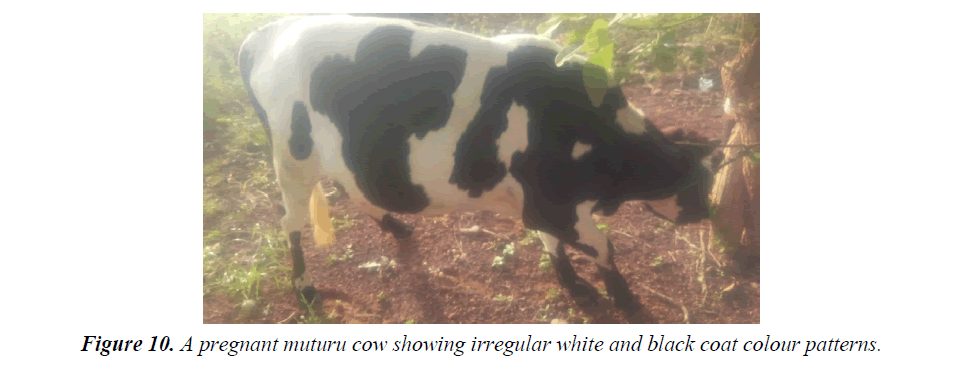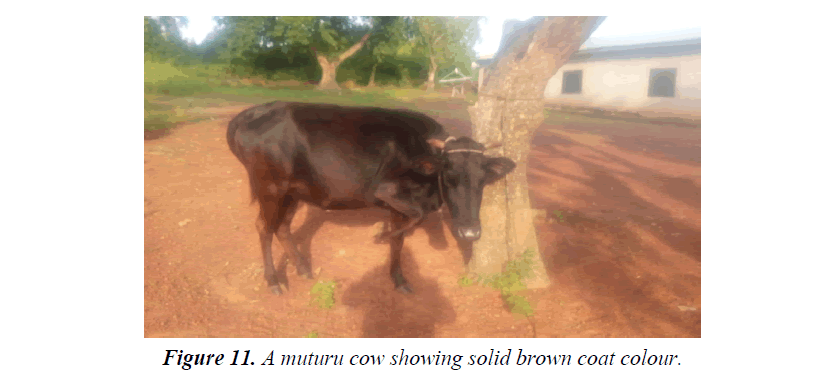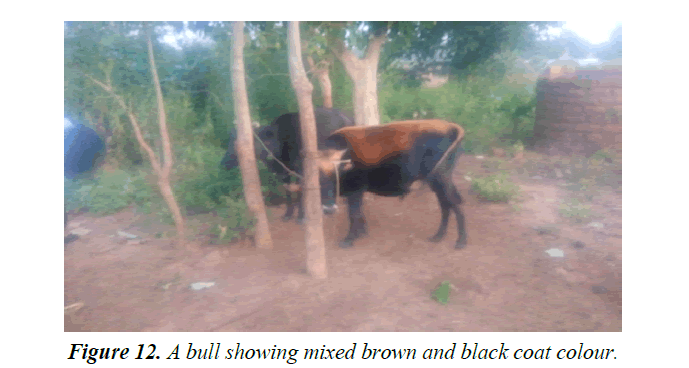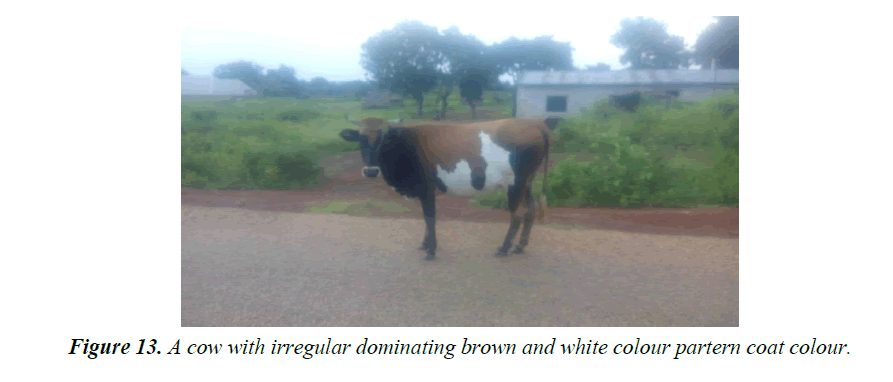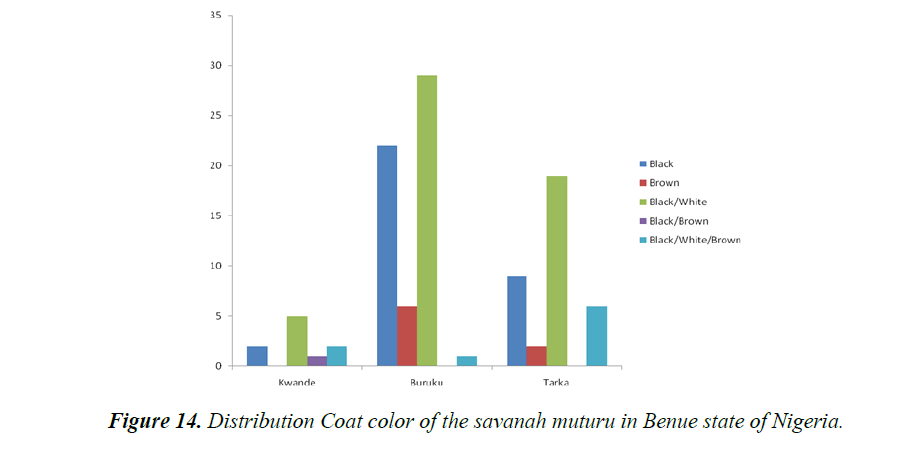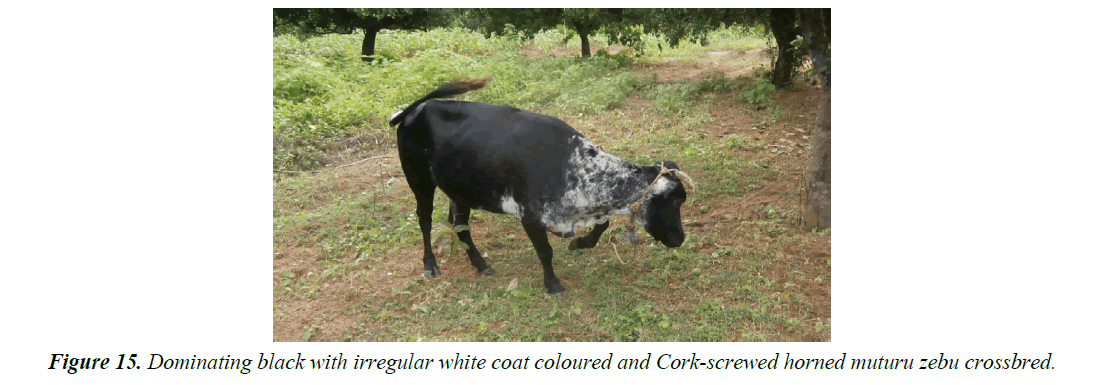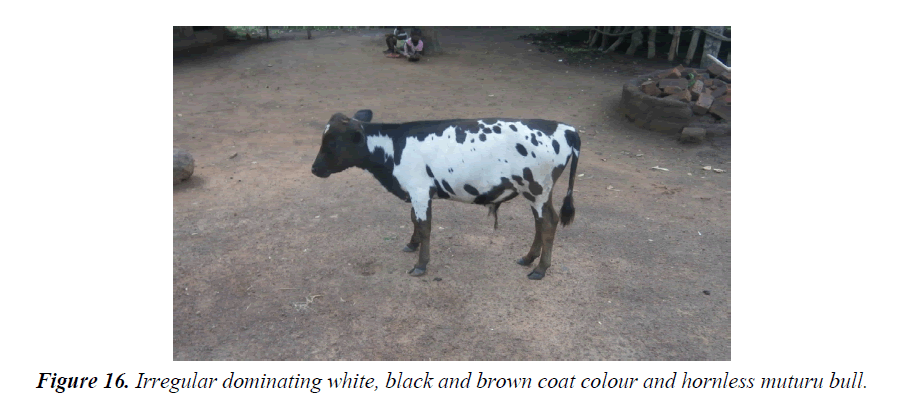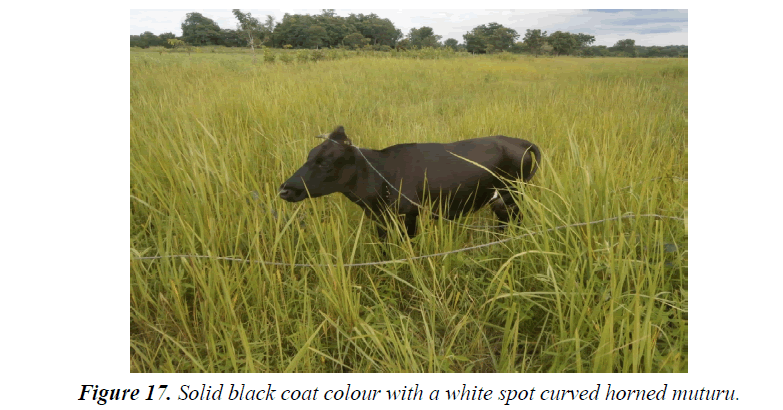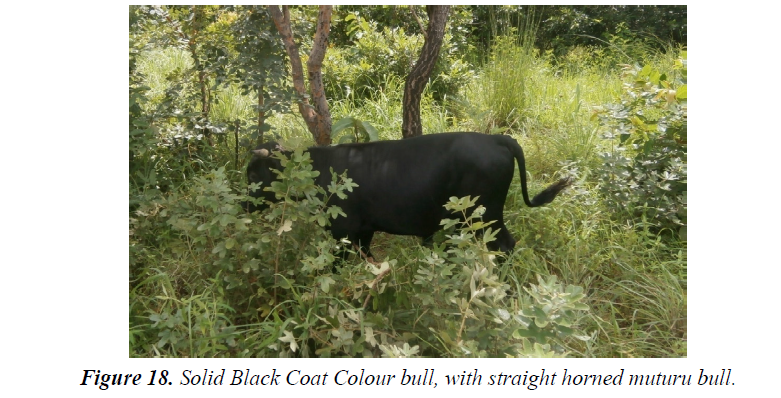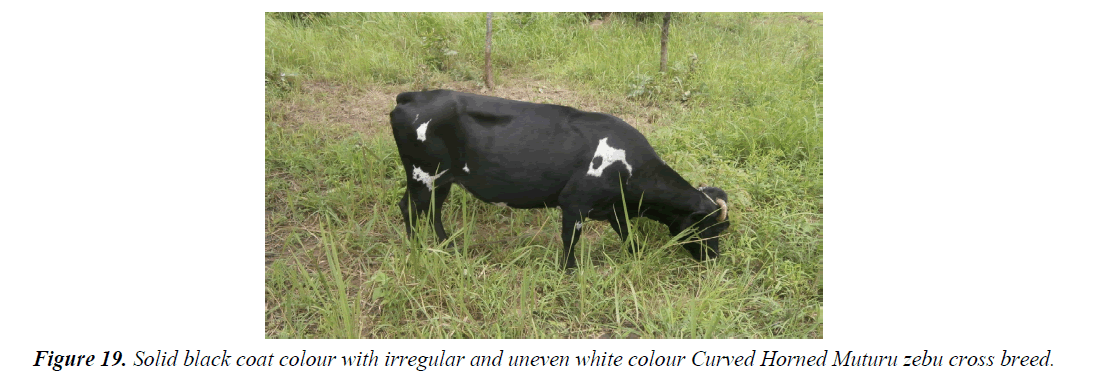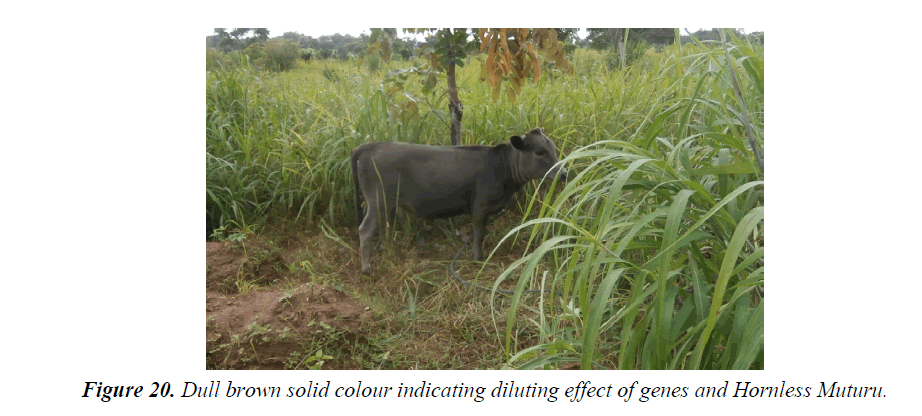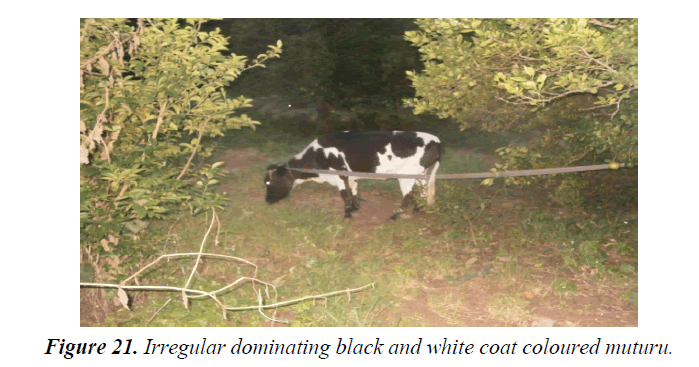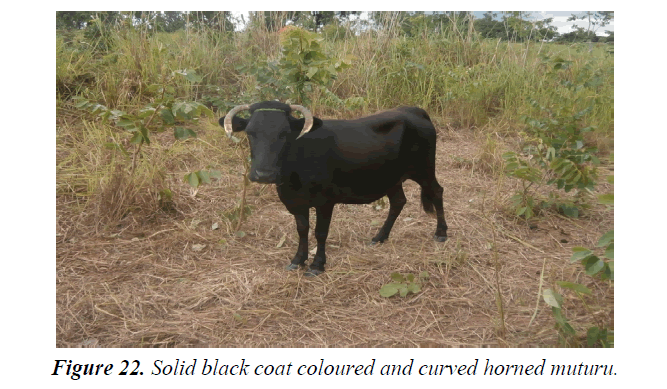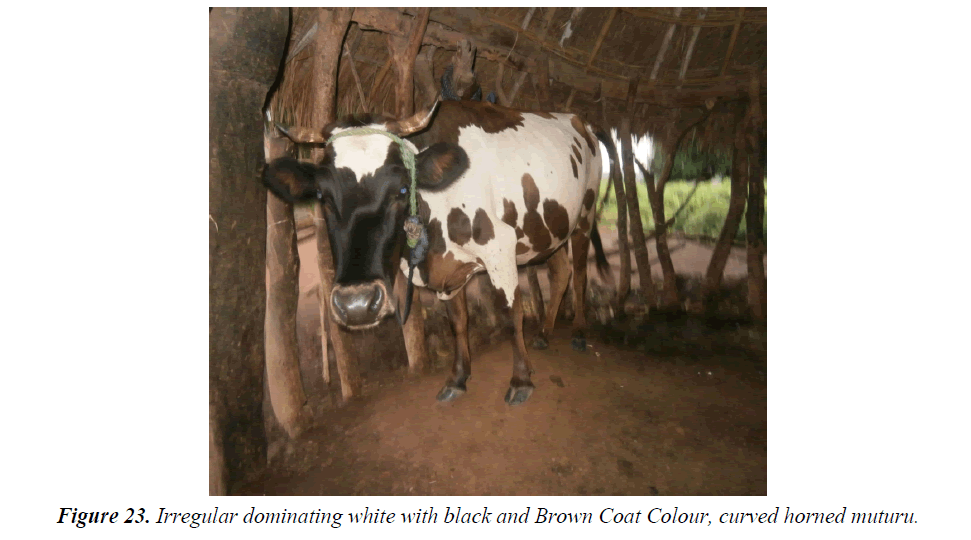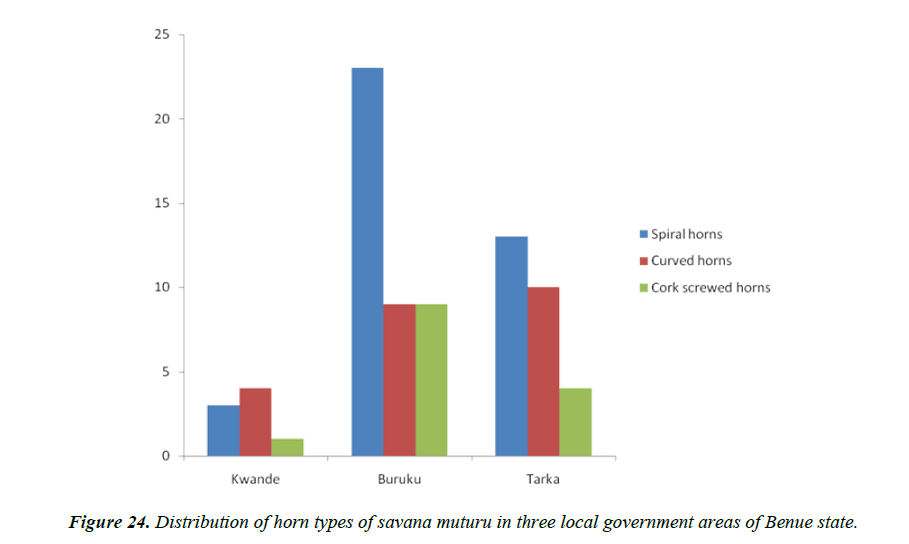Research Article - Research and Reports on Genetics (2018) Volume 2, Issue 1
Variation and distribution of qualitative traits of the savannah muturu on free range in the Benue trough of Nigerian.
Gwaza DS*, Yahaya M, Ahemen TDepartment of Animal Breeding and Physiology, University of Agriculture, Makurdi, Nigeria
- *Corresponding Author:
- Gwaza DS
Department of Animal Breeding and Physiology
University of Agriculture
Nigeria
Tel: 234445332045
E-mail: gwazadeeve@yahoo.com
Accepted Date: February 15, 2018
Citation: Gwaza DS, Yahaya M, Ahemen T. Variation and distribution of qualitative traits of the savannah muturu on free range in the Benue trough of Nigerian. J Res Rep Genet. 2018;2(1):33-43
Abstract
The study was carried out at two council wards each in Logo and Tarka local government areas of Benue State, Nigeria. The study was designed to investigate qualitative traits variation and distribution within and between populations of the savannah muturu herds on free range under rural farmers. There were coat color variations of solid black, solid brown, dominating black with irregular distribution of white patches, dominating brown with irregular distribution of black and white patches, dominating white with irregular distribution of black patches, coat colors of irregular black and white patches of uneven distributions, restricted color patterns of black and white, brown and white, and white and black. There was wide deviation from reported coat color patterns of the savannah muturu of multiple coloration, ebony, faun, white and black patches of equal dimensions and uniform distribution over the entire body. It was evidenced that the coat color genes of the savannah muturu cattle under rural farmers had undergone divergence due to inbreeding, random sampling, counter selection and genetic drift.
Keywords
Coat-color, Distribution, Genetic-divergence, Random-sampling, Savannah-muturu, Variation.
Introduction
Muturu breed; a variety of the West African short horn is known as the Nigeria short horn. The Nigerian muturu cattle breed is categories into two groups; the forest muturu in the south-west and savanna muturu in the middle belt and Eastern parts of the country [1]. Its relatives, the Liberian dwarf found in Liberia and Bakwiri found at the foot of mount Cameroon in South-West Cameroon. There is no much information about these breeds as they are sometimes classified as almost extinct. Muturu cattle are reared on free range for traditional ceremonies such that ritual restrictions surround their management [1]. The males are often slaughtered for ceremonies or for sales. The breeding potential of the muturu is challenged even under traditional management due to small herd sizes and management conveniences. The muturu cattle can sustain productivity under tsetse-stressed environment on free range without feed supplementation. During the Nigerian civil war, 1967-1970, it was recorded that many muturu cattle were slaughtered to feed the starving human population. They were thus decimated both during and immediately after the civil war [1]. Muturu have an important place in traditional culture and this affects their management and marketing [1].
The trypanotolerant muturu cattle breed is one of the least known cattle breed in West-Africa. Its distribution, morphological characteristics and performance have received little publications [1]. Early reports showed that the muturu were once distributed widely across the West-Africa sub region until the Fulani invasion of 1820 [2]. The muturu were found in all coastal countries and also in the southern part of Upper Votta (Burkina Faso). The muturu originated from the shorthorn hump less (Brachyceros) cattle which appeared in ancient Egypt in the middle of the second millennium and were first recorded in West Africa during the second half of the first millennium. This breed are found in west-Africa coastal regions, heavily infested with tsetse flies and as a result through adaptation and selection have become tolerant to trypanosomosis, resistant to ticks and tick born disease [3].
Morphological characterization of muturu cattle revealed color shades of ebony black, faun, black and white, black with white patches, white with brown or black spots of varying frequencies ranging from 39-90 percent [1-4]. There are two groups of muturu breeds in Nigeria, the savannah muturu which is the larger type and the forest muturu, the dwarf type which appears to have evolved through adaptation to the humid forest environment. Body size is the only distinction between the two strains as they are both called muturu. These breeds often possess unique genetic potential that enable their survival in a diverse range of production environment with intense stresses. The genetic diversity of indigenous livestock breeds provides mitigation to the impacts of climate change and a new growing consumer demands. Breed characteristics studies establishes reliable estimates of gradual morphological divergence and structural variations between breeds populations. Changes in breed characteristics are indicators of genetic resource divergence or dilution. In animal populations managed under rural farmers, changes in breed characteristics could be detrimental as these may either be due to loss of alleles due to random sampling or loss of heterozygosity due to inbreeding. A combination of allelic differentiation through random sampling and genetic drift accelerated by natural selection in small populations could modify or even eliminate known breed characteristics. Known qualitative characteristics may also be affected by genetic dilution through indiscriminate crossbreeding and high rate of inbreeding enhancing allelic frequencies differentiation, genetic divergence and drift [5-10].
The Nigerian muturu cattle breed had received little research attention even though the breed plays significant roles in cultural values and rural communities source of livelihood. The loss of the genetic resources of the savannah muturu will no doubt reduces opportunities to develop rural economics as well as loss of products and services preferred by local people. The value of the savannah muturu cattle breed must therefore, be considered within the broader context of sustaining rural communities and their existing economic foundations.
There is no much research reports on the performance characteristics of the savannah muturu. It is however no doubts that, their populations must have undergone severe pressures from the zebu cattle, climate change impact, modernization and poor economics of production driving force such that their populations must have declined over the years. Farmers counter selection of superior animals for use will also play a significant role in the loss of alleles from the populations. It is important to note the status and trends of animal genetic resource divergence of indigenous animals under rural farmers, because they are the only custodian of the indigenous livestock genetic resources who lacks the capacity to manage these genetic resources for sustainable use. The objectives of this study were to investigate variations in qualitative traits and their distributions between and within populations that characterized the savannah muturu cattle in Nigeria, with a view to highlight current qualitative traits that characterizes existing populations of the Nigerian savannah muturu [11].
Materials and Methods
Study area
This research work was carried out at Ayilamo–Tombo council ward in logo and Tarka local government areas of Benue State. Ayilamo is a rural community located at a boundary between Wukari of Taraba State in Logo Local Government of Benue state. The study also included some selected locations in Tarka local government such as Mbaayogh, Mbakyagh and Mbahar council wards. The community is located at latitude 70 461 21’’ N and longitude 90 71 29’’ E with an altitude of 217 m. It has temperature range of 24°–32°C, and a relative humidity of 65% to 82%, precipitation of 35%-40% [12]. The terrain in the environment is generally very variable with Neutral soil pH (5.5– 8.5) there is natural vegetation of tree cover making up 45%.
Experimental animals and their management
The animals that were used for the research were savannah muturu cattle comprising both sex and ages. The total number of the animals used for the research were 138, comprising of 35 number of males and 103 number of females. Out of the total number of the animals, thirty six (36) were calves, nineteen (19) were breeding bulls, 56 were breeding cows and twenty seven (27) were heifers. There was no castrated bull among all the samples. The populations were drawn from Logo and Tarka local government area of Benue State [13]. The animals were managed under free range with no supplementary feeding, there is no evidence of veterinary care for the animals.
Experimental procedure and materials used
Physical assessment of body coat color of individuals were taken using digital camera and phenotypic identification. One on one discussion and oral interview with the farmers was carried out for obtaining information from farmers. GPS Gadget and camera were used to identify location and for photographing of color patterns respectively.
Parameters that were measured
Body coat colors, coat color distribution, horn types, horn types distribution and horn orientation were assessed.
Data collection and analysis
The data collected from the study were subjected to descriptive statistics.
Results
Coat color distribution of the savannah muturu under rural farmers in Benue state Tarka local government area
Coat color varied across the population of the savannah muturu in Benue state. Figure 1 shows that the percentage coat color distribution of the savannah muturu in Tarka was highest in mixed patches followed by the solid black coat color. Dark brown coat color was the least Figure 1. While in Figure 2, in Logo local government area, the black coat color was dominant. This was followed by the mixed patches coat color while dark brown coat colored were least Figure 2 black coat color as in Figures 3-13 representing 30-80% of the 104 sampled population while Brown contributed as in plate 11 and 9 representing 7.7 percent, Black and white as in Figures 3,6,8,9,10,12 representing 51 percent. Black-brown coat color 1.9 percent and Black–brown– white color pattern as in Figures 1, 2,4,7,14 representing 8.7 percent.
As shown in the plates below, the coat color ranges from solid black Figures 1,4,5,6 to dark brown (Figure 10), mixed coloration of black and white patches (Figures 2,3,9) mixed brown and white patches (Figure 11), brown and black patches (Figure 12).
Distribution of coat color of savanah muturu in logo and Ushongo local government areas of Benue state
Distribution of coat color of savannah muturu in Logo local government area of Benue state were mixed coloration, solid black, solid brown and black brown coat colors. In Ushongo local government area of Benue state the distribution of coat colors of savannah Muturu were brown as shown on Figures 1,2,10. Mixed colors Figures 3,4,7, 12. Others were solid black Figures 8,9,13 solid brown. Black coat color as in Figures 3,8,9 representing 30 percent of the sampled population while Brown (Figures 11-14) contributed 7.7 percent. Mixed colors as on Figures 8,3,6,7,8,10,13 contributing 51% percent, black-brown 1.9 percent and Black brown 8.7 percent. Dull brown coat color as shown on Figures 15-17.
Distribution of horn types of the savanah muturu in Benue state of Nigeria
Distribution of horn types of muturu in Kwande local government area of Benue state: Distribution of horn types, (presence, absence, types and orientation) of savannah muturu cattle in Kwande local Government area of Benue state, animals with horns constituted 72.1% , those without horns constituted 27.9%. In the seventy two percent (72.1%) that had horns, about thirty five percent (35.34%) had straight horns (Figures 4,5,8,9,14) while about sixteen percent (16.53%) had curved horns (Figures 3,10,13,14) About one percent (0.72%) animals had cork-screwed horn orientation (Figure 6). None of the animals had spiral horn type [14].
Distribution of horn types of muturu in Buruku local government area of Benue state: Distribution of horn types, (presence, absence, types and orientation) of savannah muturu cattle in Buruku local Government area of Benue state, animals with horns constituted 76.56% , those without horns constituted 23.76%. In the seventy six percent (76.56%) that had horns, about forty three percent (43.32%) had straight horns (figures), while about ten percent (10.26%) had curved ( ) and corkscrewed horn orientations ( ) respectively. None of the animals had spiral horn type Figures 18-20.
Distribution of horn types of muturu cattle in Tarka local government area of Benue state: Distribution of horn, (presence, absence, types and orientation) of savannah muturu cattle in Tarka local Government area of Benue state, animals with horns constituted 9.99%, those without horns constituted 3.30%. In the percentage (9.99%) that had horns, about three percent (3.51%) had straight horns (plates), while about two percent (2.70%) had curved ( ) and cork-screwed (1.08%) horn orientations respectively. None of the animals had spiral horn type.
Discussion
Distribution of qualitative traits of muturu cattle in the studied population
Variation and Distribution of coat colors of muturu cattle in the studied population: The result of this study reveals that coat colors of the savannah muturu under rural farmers ranges from solid black, solid brown and multiple colorations of irregular black and white distribution, black and brown patches of unequal distribution. Dominating white with irregular black patches, dominating black with unequal distribution of white, brown and white patches. There were more solid colorations than the coat color distribution reported for the savannah muturu in Nigeria [1]. The multiple coloration observed in this study of one colour dominating the color patterns also differ from the reported multiple coat color pattern of the savannah muturu in Nigeria. The irregular dimensions and sizes of coat color distribution of color patterns of the savannah muturu also did not agree with earlier report on coat color pattern of the savannah muturu in Nigeria [1]. Reports revealed that coat color pattern of the savannah muturu color were color shades of ebony black, faun, black and white patches of equal dimensions and uniform distribution over the whole body. Black white patches, white with brown and /or black spot of varying frequencies ranging from 39-90 percent [1].
This variation in color patterns of the savannah muturu in this study could be attributed to high rate of inbreeding and uncontrolled crossbreeding with the zebu cattle. The animals with one color dominating other colors with unequal and undefined pattern of distribution over the entire body could be crossbreds with the zebu cattle. Animals with multiple color patterns with near uniform distribution and sizes and those with solid colors could be inbreeds. This is so because, since coat color is a qualitative trait, controlled by a pair or few pairs of genes and are not affected by the environment, the loss of characteristics coat coloration of the savannah muturu would only occur when genes responsible for these colorations are lost. This could only occur through crossbreeding when these genes are mask or through inbreeding when they are lost due to random sampling, allelic drift and natural selection. It is reasonable to infers that the population of the savannah muturu under rural farmers in the Benue trough of Nigeria are highly inbreeds and crossbreeds of the zebu cattle. This is valuable because members of different populations could be used in strategic breeding program design to improve and conserve the genetic resources of the savannah muturu in Nigeria with high selection response. It is also important to note that the coadapted gene complexes of the savannah muturu had not been lost as indicated by their existence and performance under rural farming communities. This result indicated that the genetic resources of the savannah muturu had not been lost over the years. The genetic uniqueness of the breed though diluted is still abounding in herds maintained among rural farmers. Certain qualitative characteristics have been lost or modified due to allelic differentiation through random sampling, drift, genetic divergence, inbreeding and crossbreeding (Figures 20-24).
Animals with horns constituted 72.1%, while those without horns constituted 27.9%, 29 out of the animals that had horns, the distribution were straight horns, curved horns and cork - screwed horns. This observation was also reported by Adebambo [1]. This result indicated that the genetic resources of the savannah muturu that influenced horn types still existed among rural herds despite climate change impact and other genetic erosion pressures on the breed over the years. The existence of the genetic resources of the breed enhancing horn profiles in rural muturu herds attest to the maintenance, capacity and potential of the co-adapted gene complexes for current and future adaptation of the breed on free range among rural farmers [15-18].
Conclusion and Recommendations
Conclusion
They were color patterns of solid black, solid brown, dominating black, with irregular distribution of white patches, dominating brown with irregular distribution of white and black patches, dominating white with irregular distribution of black patches, irregular black and white patches of unequal dimensions, restricted black and white color patterns, restricted brown and white color patterns restricted white and black color patterns. There was wide deviation of reported color patterns of the savannah muturu from the multiple ebony, fare, white and black color distributions of equal dimensions and uniform distributions. It is evidenced that the color gene of the savannah muturu cattle under rural farming communities had under- gene divergence due to inbreeding, random sampling and genetic shift.
Recommendations
Following the result of the study, the following conclusions were drown.
1. There was wide variation between reported qualitative and current qualitative traits observed on current populations of the savannah muturu under rural farmers.
2. There was genetic divergence on influence of genes influencing coat colors. These divergence was distributed throughout the rural muturu populations on free range under rural farmers.
3. There were mixed genetic grades of the savannah muturu under rural farming communities, the highly inbred and the cross bred genetic grades.
4. The genetic values and resources of the savannah muturu still existed among rural farming communities. Appropriate selection with design breeding strategy can reconstitute and improve the genetic value and known characteristics of the savannah muturu under rural farmers.
References
- Adebambo AO. The muturu: A rare sacred breed of cattle in Nigeria. Animal Genetic Resource Information. 2001;31:27-36.
- Epstein H. The origin of the domestic animals of Africa New Yolk: Africana Publishing Corporation. 1971;2:585-629.
- Adeniyi KO. Proceedings of expert committee meeting, animal genetics resource in Africa. 1985.
- Blench, Roger M. Why are there so many pastoral people in East Africa? In: Pastoralists under pressure? 1999;29-49.
- Blench, Roger M, Maitland P, et al. West African Dwarf shorthorn cattle in Nigeria: History, Distribution and Productivity. 1998a.
- Blench RM, De Jode A, Gherzi E, et al. The agricultural and forest products of British West Africa. John Murray, London: Longman. 1998b.
- Ferguson W. Muturu cattle of Western Nigeria. Journal of the West Africa Science Association. 1967;12:37-44.
- Fitzpatrick JFJ. Some notes on the Kwolla district and its tribes. Journal of the African Society. 1910;10(37):16-52.
- Grandin Barbara E. Small cows, big money, Wealth and dwarf cattle production in South Western Nigeria, Ph.D thesis, Stanford University. 1980:496.
- Gwaza DS, Momoh OM. Endangered indigenous Cattle Breeds of Nigeria a case for their conservation and management. World Scientific News. 2016;30:68-88.
- ILCA. Trypanotolerant Livestock in West and Central Africa. ILCA monographs 2. ILCA, Addis Ababa. 1979.
- Maule JP. The Cattle Tropics, Centre for Tropical Veterinary Medicine, University of Edinburgh. Redwood Press Limited, Melksham, Wiltshire. 1990;65-68.
- Oyenugu VA. Agriculture in Nigeria. An Introduction. Rome, FAO. 1967;326.
- Rege JEO, Aboagye GS, Tawah CL. Short horn cattle of West and Central Africa. World Animal Review. 1994;78:2-48.
- RIM. Nigerian National Livestock Resource Survey. Report by Resource inventory and management limited (RIM) to FDL and PCS, Abuja, Nigeria. 1992.
- Roberts CJ, Gray AR. Studies on trypanosome-resistant cattle. The breeding and growth performance of N’Dama muturu and zebu cattle maintenance under the same conditions of husbandry. Tropical Animal Health and Production. 1973;5:211-9.
- Roberts CJ, Gray AR. Studies on Trypanosome resistant cattle I-II. Tropical Animal Health and Production. 1973;5(4)220-33.
- Rogers B. Traditional Livestock Breeds: Geographical Distribution and Dynamics in Relation to the Ecology of West Africa. Working and Discussion Papers. 1999;122:19.
